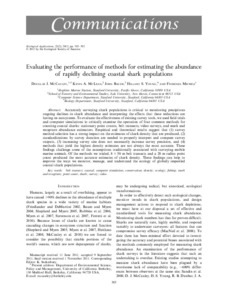| dc.contributor.author | Macauley, Douglas J. | |
| dc.contributor.author | Mclean, Kevin A. | |
| dc.contributor.author | Bauer, John | |
| dc.contributor.author | Young, Hillary S. | |
| dc.contributor.author | Micheli, Fiorenza | |
| dc.date.accessioned | 2019-01-10T23:58:35Z | |
| dc.date.available | 2019-01-10T23:58:35Z | |
| dc.date.issued | 2012 | |
| dc.identifier.citation | McCauley, D. J.; McLean, K. A.; Bauer, J. ; Young, H. S. and Micheli, F. (2012) Evaluating the performance of methods for estimating the abundance of rapidly declining coastal shark populations. Ecological Applications, 22, pp. 385-392. DOI: 10.1890/11-1059.1 | en_US |
| dc.identifier.uri | http://hdl.handle.net/11329/652 | |
| dc.identifier.uri | http://dx.doi.org/10.25607/OBP-210 | |
| dc.description.abstract | Accurately surveying shark populations is critical to monitoring precipitous ongoing declines in shark abundance and interpreting the effects that these reductions are having on ecosystems. To evaluate the effectiveness of existing survey tools, we used field trials and computer simulations to critically examine the operation of four common methods for counting coastal sharks: stationary point counts, belt transects, video surveys, and mark and recapture abundance estimators. Empirical and theoretical results suggest that (1) survey method selection has a strong impact on the estimates of shark density that are produced, (2) standardizations by survey duration are needed to properly interpret and compare survey outputs, (3) increasing survey size does not necessarily increase survey precision, and (4) methods that yield the highest density estimates are not always the most accurate. These findings challenge some of the assumptions traditionally associated with surveying mobile marine animals. Of the methods we trialed, 8 × 50 m belt transects and a 20 m radius point count produced the most accurate estimates of shark density. These findings can help to improve the ways we monitor, manage, and understand the ecology of globally imperiled coastal shark populations. | en_US |
| dc.language.iso | en | en_US |
| dc.rights | Attribution-NonCommercial 4.0 | * |
| dc.rights.uri | http://creativecommons.org/licenses/by-nc/4.0/ | * |
| dc.title | Evaluating the performance of methods for estimating the abundance of rapidly declining coastal shark populations. | en_US |
| dc.type | Journal Contribution | en_US |
| dc.description.refereed | Refereed | en_US |
| dc.format.pagerange | pp.385-392 | en_US |
| dc.identifier.doi | 10.1890/11-1059.1 | |
| dc.subject.parameterDiscipline | Parameter Discipline::Biological oceanography::Fish | en_US |
| dc.bibliographicCitation.title | Ecological Applications | en_US |
| dc.bibliographicCitation.volume | 22 | en_US |
| dc.bibliographicCitation.issue | 2 | en_US |
| dc.description.sdg | 14.2 | en_US |
| dc.description.sdg | 14.4 | en_US |
| dc.description.eov | Fish abundance and distribution | en_US |
| dc.description.bptype | Guide | en_US |
| obps.contact.contactemail | mccauley@berkeley.edu | |
| obps.resourceurl.publisher | https://esajournals.onlinelibrary.wiley.com/doi/full/10.1890/11-1059.1 | en_US |
 Repository of community practices in Ocean Research, Applications and Data/Information Management
Repository of community practices in Ocean Research, Applications and Data/Information Management

